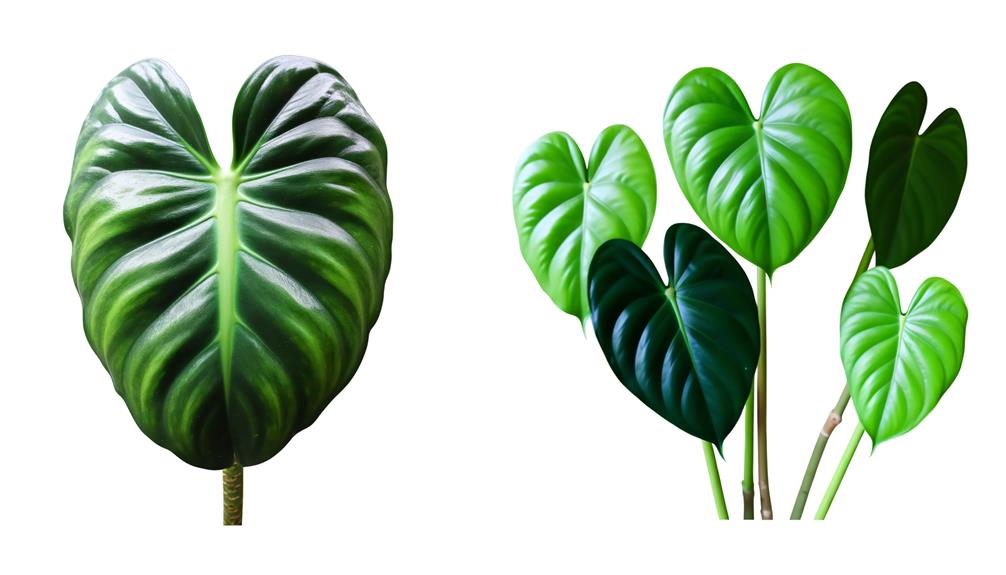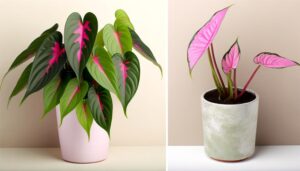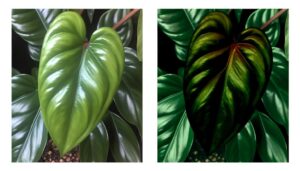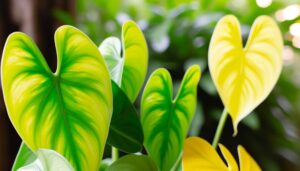Philodendron Camposportoanum Vs Micans: A Comparison!
Philodendron camposportoanum features trilobed, arrowhead-shaped foliage with a smooth, leathery texture. In contrast, Philodendron micans boasts heart-shaped, velvety leaves that display iridescence.
Camposportoanum grows moderately in high humidity and indirect light, with gradual leaf and stem development. Micans grows faster and adapts to a broader range of light conditions.
Both require well-draining soil enriched with organic matter. Camposportoanum is ideal for terrariums, while micans suits hanging baskets and climbing structures.
Consistent moisture and balanced fertilization benefit both species. Understanding these nuances can greatly enhance your plant care and placement decisions.

Comparison of Philodendron Camposportoanum and Philodendron Micans
| Characteristic | Philodendron Camposportoanum | Philodendron Micans |
|---|---|---|
| Leaf Shape | Trilobed, changes with maturity | Heart-shaped |
| Leaf Color | Dark green with reddish undersides | Velvety green with iridescent sheen |
| Leaf Texture | Smooth | Velvety |
| Mature Leaf Appearance | Dramatically lobed | Remains heart-shaped |
| Growth Habit | Climbing | Climbing or trailing |
| Rarity | Less common | More widely available |
| Native Region | Brazil | Caribbean, Central and South America |
| Leaf Size | Generally smaller | Can grow larger |
| Care Difficulty | Moderate | Easy to moderate |
| Light Requirements | Bright indirect light | Tolerates lower light conditions |
Appearance
The Philodendron camposportoanum and Philodendron micans exhibit distinct morphological characteristics that are essential for accurate identification and classification.
Philodendron camposportoanum typically features trilobed leaves with pronounced venation, presenting a somewhat arrowhead shape. Its petioles are robust, supporting the foliage effectively.
Contrastingly, Philodendron micans is characterized by its heart-shaped leaves, which often display a more uniform, ovate form. The juvenile leaves of P. micans are markedly smaller and more delicate compared to the mature, larger leaves of P. camposportoanum.
Additionally, P. micans exhibits internodal spacing that is generally more compact, creating a denser overall appearance. These specific morphological traits enable botanists and enthusiasts to differentiate between the two species with precision and confidence.
Foliage Texture
Concerning foliage texture, Philodendron camposportoanum displays a smooth, leathery surface, whereas Philodendron micans is characterized by its velvety, almost iridescent leaf coating.
The camposportoanum’s leaves are notable for their robustness and resistance to physical damage, making them resilient in diverse environments. In contrast, the micans’ leaves offer a tactile experience reminiscent of fine suede, providing a luxurious feel that is visually enhanced by their light-reflecting properties.
To illustrate:
- Philodendron camposportoanum: Smooth, leathery, robust.
- Philodendron micans: Velvety, iridescent, delicate.
- Textural Impact: The camposportoanum’s durability contrasts with the micans’ ornamental, tactile appeal.
This distinction in foliage texture not only affects the plants’ physical interaction but also their aesthetic placement within interior design and horticultural settings.
Growth Rate
The growth rate of Philodendron Camposportoanum and Micans varies greatly, primarily influenced by their speed of maturation and ideal growth conditions.
Philodendron Camposportoanum exhibits a moderate growth rate, maturing steadily under conditions of high humidity and indirect light.
Conversely, Philodendron Micans has a faster growth rate, thriving in environments with consistent moisture and bright, indirect sunlight.
Speed of Maturation
Evaluating the growth rate of Philodendron camposportoanum and Philodendron micans reveals significant differences in their speed of maturation, influenced by factors such as light availability, humidity, and nutrient intake.
Philodendron camposportoanum typically exhibits a moderate growth rate, marked by:
- Gradual leaf expansion – Leaves unfurl over several weeks, developing distinctive lobed shapes.
- Steady stem elongation – Stems grow consistently, yet not rapidly, indicating a balanced energy allocation.
- Root system development – Roots spread gradually, ensuring stable plant support.
Conversely, Philodendron micans demonstrates a swifter growth pace, characterized by:
- Rapid leaf production – New leaves emerge quickly, displaying velvety texture.
- Accelerated vine growth – Vines extend more rapidly, optimizing space coverage.
- Efficient root proliferation – Roots expand promptly, facilitating robust nutrient uptake.
Optimal Growth Conditions
Understanding the distinct growth rates of Philodendron camposportoanum and Philodendron micans necessitates an examination of their best growth conditions. These conditions encompass specific light levels, humidity ranges, and nutrient availability.
Philodendron camposportoanum thrives in bright, indirect light and high humidity levels (60-80%), with soil that is well-draining yet retains moisture. It prefers temperatures between 65-80°F.
Conversely, Philodendron micans flourishes under moderate to bright indirect light, with humidity levels around 40-60%. It requires a well-aerated, organic-rich substrate to support its growth.
Both species benefit from regular, balanced fertilization during the growing season. Importantly, the camposportoanum exhibits a faster growth rate under best conditions, whereas micans grows more steadily, necessitating consistent environmental parameters for sustained development.
Light Requirements
Understanding the light requirements for Philodendron Camposportoanum and Philodendron Micans is essential for optimizing their photosynthetic efficiency and overall health.
Both species thrive in bright, indirect light, yet nuances in their ideal light conditions necessitate tailored indoor lighting strategies.
Adjusting light exposure through techniques such as the use of sheer curtains or artificial grow lights can mitigate the risk of photoinhibition or photodamage.
Ideal Light Conditions
Philodendron Camposportoanum and Philodendron Micans both thrive in bright, indirect light, although their tolerance to different light intensities can influence their growth and foliage coloration.
Camposportoanum, with its velvety leaves, prefers slightly shadier conditions compared to Micans, which can adapt to a broader range of light levels.
Observations indicate the following:
- Bright, Indirect Light: Both species flourish under filtered sunlight, ideally near an east or west-facing window.
- Moderate Light Tolerance: Micans can tolerate lower light levels more effectively, maintaining its vibrant hue and growth.
- Direct Sunlight Avoidance: Direct exposure can cause foliar burn, especially in Camposportoanum, leading to discoloration and reduced importance.
Understanding these light preferences ensures vital plant health and aesthetic appeal.
Indoor Lighting Tips
Promoting ideal indoor lighting conditions for Philodendron Camposportoanum and Philodendron Micans involves strategically placing the plants to receive bright, indirect light while avoiding direct sunlight exposure. Bright, indirect light mimics their natural understory environment, enhancing photosynthetic activity without causing light damage.
Positioning near east or north-facing windows guarantees sufficient light levels, while sheer curtains can soften intense sunlight from south or west-facing exposures. Using artificial light sources, like fluorescent or LED grow lights, can complement natural light, especially during shorter winter days.
Monitoring light intensity with a light meter can further fine-tune placement, ensuring that the light levels remain within the ideal range of 200-400 foot-candles. This care prevents elongation and maintains overall plant health.
Light Adjustment Strategies
Adapting light conditions for Philodendron Camposportoanum and Philodendron Micans involves a systematic approach to replicate their native understory habitat, maximizing both plant growth and health. These tropical species thrive under indirect, filtered light.
Precise light adjustment strategies include:
- Diffuse Lighting: Utilize sheer curtains or shade cloths to filter sunlight, reducing intensity and mimicking forest canopies.
- Artificial Lighting: Employ full-spectrum grow lights, positioned at an optimal distance to prevent leaf scorch while ensuring sufficient light exposure.
- Rotational Positioning: Regularly rotate the plants to ensure even light distribution, preventing phototropic bending and uneven growth.
Such strategies guarantee these philodendrons receive consistent, moderate light levels, essential for maintaining their vibrant foliage and overall well-being.
Watering Needs
Ideal hydration for both Philodendron camposportoanum and Philodendron micans requires a careful balance that takes into consideration their sensitivity to both overwatering and drought conditions. These species thrive in environments where the soil remains consistently moist but not waterlogged.
To achieve the best possible hydration, consider the following:
| Parameter | Philodendron camposportoanum | Philodendron micans |
|---|---|---|
| Water Frequency | Moderate, every other week | Moderate, every other week |
| Soil Moisture | Evenly moist | Evenly moist |
| Watering Method | Bottom watering preferred | Bottom watering preferred |
Regularly monitor the top inch of soil; it should be slightly dry before the next watering. Using a moisture meter can help prevent root rot, a common issue with improper watering. This careful approach ensures strong growth and vibrant foliage.
Soil Preferences
Ideal soil composition for Philodendron camposportoanum and Philodendron micans requires a well-draining, aerated medium enriched with organic matter to support their nutrient uptake and root health. This can be achieved through a balanced mix that maximizes both moisture retention and adequate aeration.
Key components include:
- Peat moss: Enhances moisture retention while providing organic matter.
- Perlite: Improves drainage and aeration, preventing root rot.
- Bark chips: Adds structure, promoting air circulation and mimicking natural forest floor conditions.
Such a soil mix creates an excellent environment for these species, fostering vigorous growth and robust root systems. The incorporation of these elements maximizes the potential for both Philodendron camposportoanum and Philodendron micans to thrive, showcasing their full ornamental beauty.
Ideal Uses
Philodendron camposportoanum and Philodendron micans exhibit exceptional versatility as ornamental plants, making them suitable for both residential interiors and botanical collections.
The velvety, heart-shaped leaves of Philodendron micans add a touch of sophistication to living spaces, often utilized in hanging baskets or climbing structures to maximize vertical aesthetic appeal.
Conversely, Philodendron camposportoanum‘s unique, lobed leaves make it a focal point in terrariums or as a standalone potted plant, enhancing visual interest with its dynamic foliage.
Both species thrive in controlled environments, benefiting from indirect light and humidity, which replicate their native tropical habitats.
Consequently, these philodendrons are integral to interior landscaping, offering both ecological benefits and aesthetic enhancement, thereby enriching the ambiance of diverse settings.
Conclusion
In juxtaposing Philodendron camposportoanum and Philodendron micans, stark contrasts emerge. The former, with its velvety foliage and rapid growth rate, thrives in moderate light and necessitates consistent moisture.
The latter, characterized by delicate, heart-shaped leaves, prefers indirect light and less frequent watering. Both, however, demand well-draining soil and serve as striking additions to indoor environments.
This comparative analysis underscores the unique attributes and specific care requirements essential for optimizing the growth and aesthetic appeal of each species.






